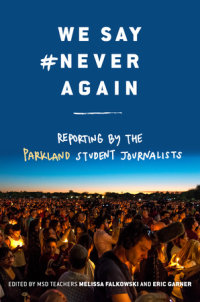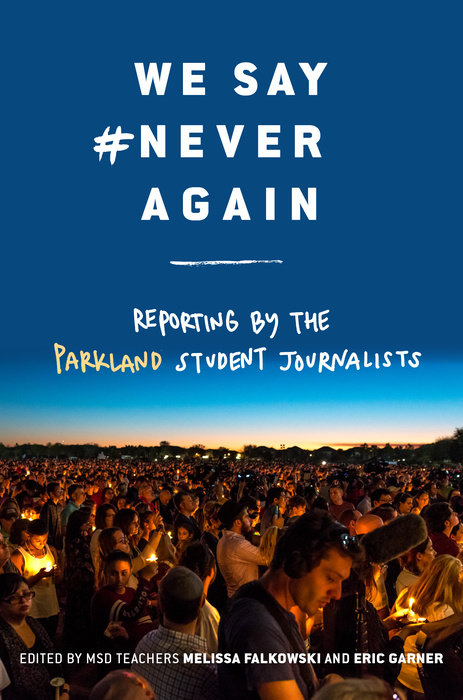We Say #NeverAgain: Reporting by the Parkland Student Journalists
A journalistic look at the shooting at Marjory Stoneman Douglas High School in Parkland and the fight for gun control--as told by the student reporters for the school's newspaper and TV station.
This timely and media-driven approach to the Parkland shooting, as reported by teens in the journalism and broadcasting programs and in the Marjory Stoneman Douglas newspaper, is an inside look at that tragic day and the events that followed that only they could tell.
It showcases how the teens have become media savvy and the skills they have learned and honed--harnessing social media, speaking to the press, and writing effective op-eds. Students will also share specific insight into what it has been like being approached by the press and how that has informed the way they interview their own subjects.
"One thing is clear: The Parkland students are smart, media savvy, and here to fight for common sense gun laws." --Hello Giggles
An Excerpt fromWe Say #NeverAgain: Reporting by the Parkland Student Journalists
The Events of February 14
by Melissa Falkowski, MSD journalism teacher
February 14, 2018, started almost like any other normal Valentine’s Day.
In my first two periods, my creative writing students wrote love advice columns and turned famous love poems into “hate” poems—an activity for the angsty anti–Valentine’s Day students. The day was filled with candy, balloons, stuffed animals, flowers, and a general show of love for each other. In first period, Samantha Fuentes shared chocolate-covered strawberries from Kilwin’s, where she had just started working. At the beginning of second period, we spent fifteen minutes outside for our monthly scheduled fire drill.
The rest of the day passed pretty uneventfully—lunch, study hall, and finally newspaper class. I worked with staffers and editors on our upcoming third-quarter issue of the newspaper and stories scheduled to post to our website. Class and the school day were almost over.
Then, at 2:21 p.m. the fire alarm sounds. The class stops what they’re doing and looks to me for directions. It’s not normal for the fire alarm to sound twice in one day, but not totally out of the question, especially if culinary is cooking.
“We gotta go, guys. Get your stuff,” I tell them.
Some of them grumble, and some of them roll their eyes. We are annoyed and inconvenienced. Haven’t we already done this today?
I grab my cell phone and my keys, grab my emergency folder, and stand at the door counting how many students leave the room—twenty-five total, the entire class listed on my fourth-period roster. I want to make sure that I have them all when I get to my assigned evacuation zone. I close my already locked door and turn left, heading the fifteen feet to the double doors that will take me to the outside hallway.
The outside stairwell is crowded. I see one of our campus security monitors. I ask her what’s going on.
“Someone set off firecrackers in the 1200 building,” she tells me.
“Okay. Idiots,” I tell her as I roll my eyes.
I turn to two other teachers to tell them.
The campus monitor calls to me. “Go back. Code Red! Code Red!”
The other teachers and I call out to the students in the hallway and the stairwell to turn around and go back. I pivot and walk quickly back to my room. As I open my door, I hear an administrator’s voice come over the intercom. “Code Red,” he says.
I’m the first teacher back to my hallway. I’m holding the door open as students file in. I’m yelling to kids in the hallway, “Get inside! Right now! Go anywhere. It doesn’t matter where you are supposed to be.”
They look confused.
Colleagues are starting to return to their classrooms and open up. One of them calls down to me and asks what’s going on.
“It’s a Code Red!” I yell to her.
“Are you serious?” she asks.
“Yes!”
Two out-of-breath students appear on my side of the hallway. I tell them to come inside. Students at the other end of the hallway are filing into classrooms. I decide to close my door. I already feel like I’ve held it open for too long.
When I turn and close the door behind me, I see all my students huddled into a corner of the room. They are in the exact place we discussed a month ago after staff training about active shooter situations. I returned from the training and mapped out an area of the room that I could make invisible from the door’s window by covering it halfway with paper.
I move into the corner, pull out the attendance roster from my emergency folder, and start calling names. In total I have nineteen students with me—two who are not mine, and seventeen of my newspaper students. I’m missing eight students. As I get to the names of missing students on the roster, I tell the other students to text them and find out where they are.
They are located quickly; they’re in the classroom beneath us in a closet. All eight of them are together. When they reached the bottom of the stairwell, another teacher pulled them inside.
I write down the names of the two extra students with me. Their classroom is across campus. I find out later that as their class evacuated for the fire alarm, they were told to just run. Their building is directly across from the 1200 building. They heard shots, but they say nothing about it to me or my students at the time.
One of my students asks me, “Mrs. Falkowski, are you going to turn off the lights?”
I forgot to turn off the lights. “Of course,” I tell her.
I get up, turn off the lights in my room, and walk into my adjacent computer lab and turn those off, too. For the few seconds when I’m in the computer lab, I almost lose my composure. I’m shaking, and I can feel the tears coming. I take a deep breath and go back to the corner in the larger room.
It’s 2:28 p.m. One student is already in the closet. She went straight there when she arrived in the room. I text my husband.
“We are in a Code Red. I’m locked in my room. With kids. I’m okay and I love you.”
I text my husband again.
“I don’t know what’s happening. It could be the drill they said they were going to do this semester. But I don’t see why they would do it at 2:30.”
Now we can hear helicopters and sirens. I google Marjory Stoneman Douglas High School. The first link says, “Shots Fired.”
I make the decision to move everyone into the closet. I pull out a cart and some things that are taking up room. I call the students over a few at a time. I tell them just to bring themselves and their phones—no backpacks. Just people, not things. I grab my phone charger from behind my desk, and we close up the closet.
The lights are off. It’s dark, hot, and crowded. We have to stand shoulder to shoulder for everyone to fit. A few students are crying in the back. I use my phone’s flashlight to illuminate the closet. I’m telling the kids over and over that everything is okay. We are together and everything is going to be okay.


